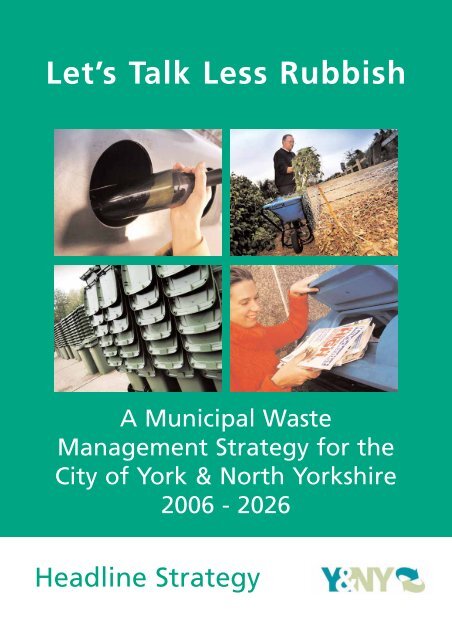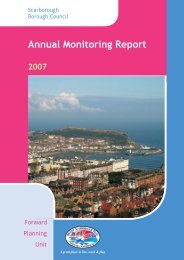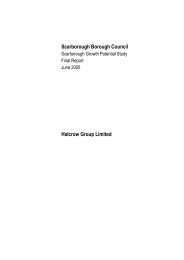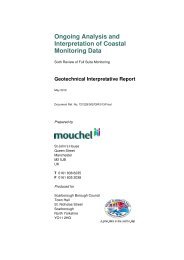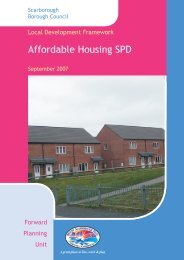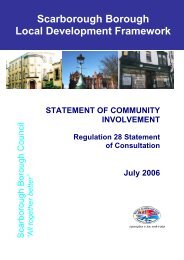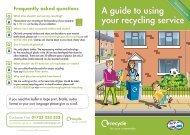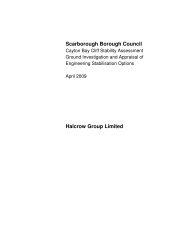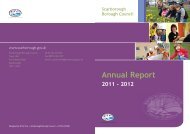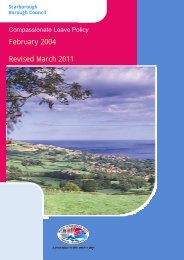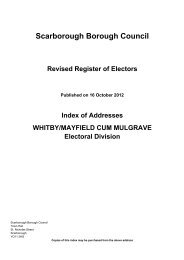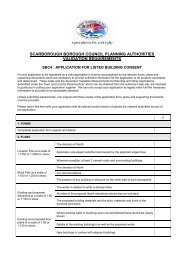Let's Talk Less Rubbish - North Yorkshire County Council
Let's Talk Less Rubbish - North Yorkshire County Council
Let's Talk Less Rubbish - North Yorkshire County Council
You also want an ePaper? Increase the reach of your titles
YUMPU automatically turns print PDFs into web optimized ePapers that Google loves.
Let’s <strong>Talk</strong> <strong>Less</strong> <strong>Rubbish</strong><br />
A Municipal Waste<br />
Management Strategy for the<br />
City of York & <strong>North</strong> <strong>Yorkshire</strong><br />
2006 - 2026<br />
Headline Strategy
This Strategy was developed by the York Y<br />
& <strong>North</strong> <strong>Yorkshire</strong>Y<br />
Waste Partnership, supported by Enviros Consulting Ltd.<br />
June 2006
Executive Summary 1<br />
Waste Reduction 2<br />
Re-use 2<br />
Recycling & Composting 3<br />
Residual Waste Treatment & Disposal 3<br />
Introduction 5<br />
Contents<br />
Scope of the Headline Strategy 6<br />
Background to ‘Let’s talk less rubbish’ 7<br />
Vision & Objectives of the Strategy 8<br />
The Current Situation in York & <strong>North</strong> <strong>Yorkshire</strong> 9<br />
Key Information 9<br />
Who is Responsible for the Service? 11<br />
How well is the Service performing now? 12<br />
Recent Achievements 13<br />
What Policy/Legislation impacts on the Service? 14<br />
The Strategy: Waste Reduction 15<br />
The Strategy: Waste Re-use 17<br />
The Strategy: Recycling & Composting 18<br />
The Strategy: Residual Waste Treatment & Disposal 20<br />
Best Practicable Environmental Option 20<br />
Conclusions on Residual Waste Treatment Options 21<br />
What about Other Wastes arising in the<br />
Partnership Area? 23<br />
How much will it Cost? 24<br />
Working Together 26<br />
Review of the Strategy 27<br />
How will this Strategy make a Difference? 28
Executive Summary<br />
This Municipal Waste Management Strategy has been developed by the York &<br />
<strong>North</strong> <strong>Yorkshire</strong> Waste Partnership and provides the strategic vision for<br />
managing wastes and improving resource recovery in York and <strong>North</strong> <strong>Yorkshire</strong>.<br />
This Strategy document contains the policies, aims, objectives, and targets for<br />
the partnership area and relates to the period of 2006 – 2026.<br />
The Strategy has been developed in response to the significant challenges<br />
facing the management of municipal waste. These include local, national and<br />
international obligations, changing environmental targets and policies, and an<br />
increasing requirement to adopt more sustainable practices in the management<br />
of wastes. Within the partnership area there are also a number of specific local<br />
challenges including a growing population, a predominance of rural areas and<br />
areas of low population density.<br />
Whilst focusing predominantly on municipal waste (that is, waste under the<br />
control of the local authorities), the Partnership is aiming towards an overall<br />
vision to:<br />
‘Work with the community and stakeholders of York and <strong>North</strong> <strong>Yorkshire</strong><br />
to meet their waste needs and deliver a high quality, sustainable,<br />
customer-focussed and cost effective waste management service’.<br />
In order to achieve this vision the Partnership has identified the following<br />
strategic objectives:<br />
• To reduce the amount of waste produced in York and <strong>North</strong> <strong>Yorkshire</strong> so as<br />
to make us one of the best performing areas 1 in the country by 2013<br />
(currently York and <strong>North</strong> <strong>Yorkshire</strong> residents produce more waste per<br />
person than in most other areas). By 2008, we aim to produce less per<br />
person than the average for England and Wales<br />
• To promote the value of waste as a natural and viable resource, by:<br />
- Re-using, recycling and composting the maximum practicable amount of<br />
household waste<br />
- Maximising opportunities for re-use of unwanted items and waste by<br />
working closely with community and other groups<br />
- Maximising the recovery of materials and/or energy from waste that is<br />
not re-used, recycled or composted so as to further reduce the amount of<br />
waste sent to landfill<br />
Whilst the rates of composting and recycling have doubled across the<br />
Partnership area from 2001/02 to 2004/05 to the figure of 21%, the amount of<br />
waste generated has also increased. This is an area of concern. In order to<br />
meet the objectives of this Strategy and respond to legislative challenges, a<br />
number of targets and policies have been set in this Strategy, focused on<br />
reducing waste arisings and improving the reuse, recycling, composting and<br />
recovery of waste.<br />
Page 1<br />
1 As determined by comparison with other Shire county performance on Best Value Performance<br />
Indicator 84
Waste Reduction<br />
Efforts to reduce the amount of waste sent for<br />
disposal have traditionally been concentrated on<br />
increased recycling and recovery of waste.<br />
However there is now a need to reduce the<br />
amount of waste produced in the first place,<br />
thereby offsetting the costs and environmental<br />
impacts of the generation, collection, treatment<br />
and disposal of waste. The Partnership as a<br />
whole generates more household waste per<br />
person than the average <strong>County</strong> area. Reducing<br />
the quantities generated will take time as new systems need to be<br />
implemented, and campaigns run to encourage residents to make permanent<br />
behavioural changes.<br />
The Partnership has set the following targets for waste reduction:<br />
Executive Summary<br />
• Contain average household waste arisings so that residents of the<br />
Partnership area generate less per head than the average for Shire counties<br />
by 2008, and<br />
• To be amongst the lowest 25% of these by 2013<br />
• Specifically annual average growth per head is to be reduced to zero % by 2008<br />
These targets are supported by a revised Waste Minimisation Strategy developed<br />
in parallel with this Strategy, to help to tackle the problem of waste growth.<br />
Re-use<br />
Waste needs to be regarded as a resource, and the availability of re-useable<br />
products needs to be advertised by working with individuals and groups<br />
involved in waste re-use (for example repairing or refurbishing redundant<br />
items into useful products).<br />
The work of the community sector has<br />
long been recognised for its<br />
contribution to waste management<br />
through community-led kerbside<br />
recycling, composting, re-use<br />
(particularly furniture re-use) and<br />
waste education schemes. The<br />
community sector also provides<br />
employment, training and educational<br />
opportunities contributing to both the<br />
economy and social well-being of the area. A ‘Community Solutions’ project was<br />
established within the area in 2004 to support charities, voluntary and<br />
community groups to get involved in waste re-use. This project focussed on the<br />
re-use of furniture and household items, but also offers support in recycling and<br />
composting activities. The project contributes to the delivery of many of this<br />
Strategy’s objectives and will help to establish a sustainable and self-supporting<br />
re-use and recycling network in the area.<br />
Page 2
Executive Summary<br />
The Partnership has set itself a policy to:<br />
• Continue to ‘involve community and other groups in maximising<br />
opportunities for re-use’.<br />
Recycling & Composting<br />
A considerable improvement in recycling and composting performance has<br />
been delivered within the Partnership area<br />
over the last five years and this has been<br />
achieved through:<br />
• The introduction of new or enhanced<br />
kerbside collection schemes<br />
• The introduction of alternate weekly<br />
collections of green and residual wastes in<br />
some areas<br />
• Improved separation of recyclable and<br />
compostable materials at Household<br />
Waste Recycling Centres<br />
• An enhanced network of ‘bring’ bank<br />
recycling facilities<br />
Recent studies have shown that a higher<br />
level of recycling is the most cost effective<br />
long term solution to delivering the<br />
Partnership’s obligations. High levels of<br />
recycling are also essential for reasons of<br />
environmental protection, delivering<br />
sustainable solutions and satisfying public<br />
expectation.<br />
Consequently the Partnership aims to achieve the following targets as a<br />
minimum:<br />
• Recycle or compost 40% of household waste by 2010<br />
• Recycle or compost 45% of household waste by 2013<br />
• Recycle or compost 50% of household waste by 2020<br />
Residual Waste Treatment & Disposal<br />
There will always be a residual proportion of waste that cannot be recycled or<br />
composted. Even with full public participation in recycling, composting and reuse<br />
schemes (and the availability of sustainable markets for recyclables and<br />
compost) there will still be a remainder for treatment or disposal. Therefore,<br />
the Partnership has set itself a target to, as a minimum:<br />
• Divert 75% of municipal waste from landfill by 2013<br />
The Partnership expects that residual waste treatment in York and <strong>North</strong><br />
Page 3
<strong>Yorkshire</strong> will be by biological and/or thermal processes. However, the ultimate<br />
technology solution may vary from the preferred options due to factors such as<br />
the availability of technology, markets for products, government policy and<br />
regulations, practicalities and cost. It is envisaged that between one and three<br />
residual waste treatment plants will be required.<br />
Although this Strategy is focussed on municipal waste, the Partnership will<br />
continue to liaise with relevant stakeholders to help improve facilities for non<br />
municipal wastes and to help to influence the reduction of wastes wherever<br />
practicable.<br />
It is crucial that the close working relationship of the Partnership since 2003 in<br />
planning and developing future waste management services in a co-ordinated<br />
way continues if the Strategy is to be a success. However, some decisions will<br />
continue to be best taken locally, provided they are consistent with the overall<br />
Strategy. These decisions will include choices on waste collection, street<br />
cleansing and local recycling initiatives. The most efficient way of delivering<br />
some council waste disposal and collection services may however be through<br />
joint contracts for waste management.<br />
Executive Summary<br />
This Strategy will be completely reviewed in 2010/11, which will allow targets<br />
to be updated and new policies introduced where appropriate.<br />
Page 4
Introduction<br />
This Municipal Waste Management Strategy, entitled ‘Let’s talk less rubbish’<br />
was developed by York & <strong>North</strong> <strong>Yorkshire</strong> Waste Partnership (hereafter known<br />
as the ‘Partnership’) which comprises:<br />
• <strong>North</strong> <strong>Yorkshire</strong> <strong>County</strong> <strong>Council</strong><br />
• City of York <strong>Council</strong><br />
• Craven District <strong>Council</strong><br />
• Hambleton District <strong>Council</strong><br />
• Harrogate Borough <strong>Council</strong><br />
• Richmondshire District <strong>Council</strong><br />
• Ryedale District <strong>Council</strong><br />
• Scarborough Borough <strong>Council</strong><br />
• Selby District <strong>Council</strong><br />
This document sets out the key principles of the Municipal Waste Management<br />
Strategy for York & <strong>North</strong> <strong>Yorkshire</strong>. It includes the policies, aims, objectives,<br />
and targets for the management of wastes and resources in the Partnership<br />
area from 2006 – 2026. It is supported by action plans, and a series of<br />
supplementary reports as illustrated in Figure 1.<br />
Figure 1 The Structure of ‘Let’s talk less rubbish’<br />
Headline Strategy<br />
Key objectives,<br />
targets & policies<br />
Action Plan<br />
How the Strategy<br />
will be delivered<br />
Supplementary<br />
Report 1<br />
Waste Minimisation<br />
Strategy<br />
Supplementary<br />
Report 6<br />
Legislation &<br />
Policy<br />
Supplementary<br />
Report 2<br />
Communications<br />
Strategy<br />
Supplementary<br />
Report 5<br />
Consultation Document:<br />
Draft Revised Waste<br />
Strategy<br />
Supplementary<br />
Report 3<br />
BPEO<br />
Study<br />
Supplementary<br />
Report 4<br />
Results of the Strategy<br />
Consultation<br />
Page 5<br />
An Action Plan detailing the delivery of the targets and policy within the<br />
Strategy and the responsibilities of the partners to ensure their delivery is under<br />
development and will be published in its final form by December 2006. It will<br />
be available from www.rethinkrubbish-northyorks.com. The six supplementary<br />
reports shown in the figure 1 provide supporting information which was<br />
considered when developing the Municipal Waste Management Strategy. All<br />
are available from www.rethinkrubbish-northyorks.com.
‘Let’s talk less rubbish’ covers the geographic area of <strong>North</strong> <strong>Yorkshire</strong><br />
including the City of York and deals with the strategic vision for managing<br />
wastes, and improving the recovery of those wastes as resources, for the period<br />
of 2006 – 2026.<br />
The focus of the Strategy is municipal waste, that is, wastes under the control<br />
of the local authorities. The majority of this type of waste comes from the<br />
household, but there are also some elements from commercial and industrial<br />
sources.<br />
The Strategy is being produced as part of a responsibility to deliver local,<br />
national and international obligations in terms of environmental targets and<br />
policies which govern how we manage our wastes.<br />
The management of municipal waste is a significant challenge, particularly in<br />
the light of recent legislation and a need to move away from the practice of<br />
disposing of the majority of our wastes in landfill sites.<br />
A new way of thinking is required to deal with our wastes more ‘sustainably’,<br />
that is considering not only our needs and environment, but also the needs and<br />
environment we are passing on to future generations. This is the central theme<br />
behind ‘Let’s talk less rubbish’ and the targets and policies explained in this<br />
document.<br />
Scope of the Headline Strategy<br />
Page 6
Background to ‘Lets talk less rubbish’<br />
This Strategy revises ‘Let’s <strong>Talk</strong> <strong>Rubbish</strong>’ 2 which was the previous Partnership<br />
Strategy document that was published in 2002.<br />
‘Let’s talk less rubbish’ reflects the current need and desire of the<br />
Partnership to re-examine the issues and commitments set out in the 2002<br />
Strategy, and to take into account relevant legislative and policy developments.<br />
It also considers recent studies undertaken within the Partnership and the<br />
recommendations made on how residual waste can be managed within the<br />
area in order to meet new and demanding legal obligations.<br />
The Strategy explains:<br />
• The Partnership’s vision for municipal waste management<br />
• Why there is a need to develop new approaches to managing waste<br />
• How much municipal waste is anticipated in future years and how growth in<br />
arisings might be controlled<br />
• Current recycling and composting performance, future requirements and<br />
targets<br />
• How waste re-use is often environmentally better and cheaper than other<br />
options<br />
• How residual waste might be treated and disposed of in future<br />
As part of developing this revised Strategy a consultation draft was issued by<br />
the York and <strong>North</strong> <strong>Yorkshire</strong> Waste Partnership (Supplementary Report<br />
number 5) for public comment during November and December 2005. The main<br />
and summary documents were available throughout this period on the<br />
Internet, and hard copies available on request.<br />
A leaflet summarising the key issues was also provided to householders and<br />
other stakeholders together with a short questionnaire.<br />
A total of 2944 responses were returned. These responses were analysed by<br />
consultants 3 and the results of the consultation informed the development of<br />
this Strategy. The summary of the consultation response is contained in<br />
Supplementary Report Number 4, headed “Results of the Strategy<br />
Consultation” and available from www.rethinkrubbish-northyorks.com.<br />
In addition, several studies were carried out to support the development of the<br />
Strategy. The most significant of these was the Best Practicable Environmental<br />
Option (BPEO) appraisal 4 for York and <strong>North</strong> <strong>Yorkshire</strong>. This study considered<br />
different scenarios for municipal waste management and provided a steer as to<br />
the most appropriate choices. The BPEO reports were subject to consultation<br />
and stakeholder input. The BPEO report is Supplementary Report Number 3 and<br />
is available from www.rethinkrubbish-northyorks.com.<br />
The Partnership and key stakeholders have considered the responses to the<br />
draft Strategy consultation and the supporting technical information in the<br />
finalisation of this Strategy document. The Strategy reflects the views of the<br />
Partnership as to the future development of municipal waste management<br />
across York and <strong>North</strong> <strong>Yorkshire</strong>.<br />
Page 7<br />
2 Let’s <strong>Talk</strong> <strong>Rubbish</strong> – Developing a Waste Strategy for York and <strong>North</strong> <strong>Yorkshire</strong>, YNYWMP, July 2002<br />
3 RBA Research Ltd.<br />
4 Assessment of the Best Practicable Environmental Option for Municipal Solid Waste Arising in<br />
<strong>North</strong> <strong>Yorkshire</strong> <strong>County</strong> <strong>Council</strong> & City of York <strong>Council</strong> Final Report, ERM, January 2005
Following initial consultation with key stakeholders and with the <strong>North</strong><br />
<strong>Yorkshire</strong> Citizens Panel in September 2004, and with the residents of York and<br />
<strong>North</strong> <strong>Yorkshire</strong> through the development of this Strategy, the Partnership’s<br />
vision is to:<br />
‘Work with the community and stakeholders of York and <strong>North</strong> <strong>Yorkshire</strong><br />
to meet their waste needs and deliver a high quality, sustainable,<br />
customer-focussed and cost effective waste management service’.<br />
This Strategy has the following objectives, to enable us to achieve this vision:<br />
• Reduce the amount of waste produced in York and <strong>North</strong> <strong>Yorkshire</strong> so as to<br />
make us one of the best performing areas 5 in the country by 2013 (currently<br />
York and <strong>North</strong> <strong>Yorkshire</strong> residents produce more waste per person than in<br />
most other areas). By 2008, we aim to produce less per person than the<br />
average for England and Wales<br />
• To promote the value of waste as a natural and viable resource, by:<br />
- Re-using, recycling and composting the maximum practicable amount of<br />
household waste<br />
- Maximising opportunities for re-use of unwanted items and waste by<br />
working closely with community and other groups<br />
- Maximising the recovery of materials and/or energy from waste that is<br />
not re-used, recycled or composted so as to further reduce the amount of<br />
waste sent to landfill<br />
These objectives are linked to other national and regional guidance on waste<br />
management, planning and energy generation which influence the delivery of<br />
the Strategy. The objectives are also consistent with the generally accepted<br />
‘waste hierarchy’ which identifies that the best way to manage waste is not to<br />
generate it in the first place (reduction), followed by reusing or<br />
recycling/composting and recovering energy where practicable and finally<br />
disposal of waste, as illustrated in Figure 2.<br />
Vision & Objectives of the Strategy<br />
Figure 2:<br />
The Waste Hierarchy<br />
Waste Prevention<br />
Re-use<br />
Recycle/Compost<br />
Energy Recovery<br />
Disposal<br />
5 As determined by comparison with other Shire county performance on Best Value Performance<br />
Indicator 84<br />
Page 8
The current situation in York & <strong>North</strong> <strong>Yorkshire</strong><br />
Key Information<br />
<strong>North</strong> <strong>Yorkshire</strong><br />
<strong>North</strong> <strong>Yorkshire</strong> is England’s largest <strong>County</strong> and is home to around 576,000<br />
people in an area covering about 8654 square km. The population is rapidly<br />
growing – it increased by 0.5 per cent per year between 1991 and 2001. The<br />
<strong>County</strong>, however, is one of the most sparsely populated areas in England with<br />
only around 121 persons per square km. A total of 396,391 tonnes of municipal<br />
waste was generated in 2004/05.<br />
The area is largely rural, with Harrogate and Scarborough being the only towns<br />
above 20,000 in population. The <strong>County</strong> includes the <strong>North</strong> York Moors and the<br />
<strong>Yorkshire</strong> Dales National Parks; two Areas of Outstanding Natural Beauty and<br />
part of a third; together with 244 Sites of Special Scientific Interest (“SSSI”). In<br />
addition, the <strong>County</strong> has 45 miles of coastline that forms its eastern boundary.<br />
This predominantly rural aspect and the size of the area combined with a<br />
limited transport infrastructure to rural settlements presents particular issues<br />
for managing wastes. It often makes the operation of services more expensive<br />
than in other areas with a higher population density, where vehicles have a<br />
shorter distance to travel between properties. However, the East Coast Main<br />
Rail Line, the A1 and the M62 run through the <strong>County</strong> and these provide<br />
potential axes for waste/recyclable transportation. There are also limited water<br />
transport routes via the navigable areas of the River Ouse/Ure/Ripon Canal or<br />
through coastal routes where practicable.<br />
The area overall is above average in affluence compared to the rest of England,<br />
with all districts, except Scarborough, being above average. Unemployment is<br />
below the national average. The mix of employment sectors is similar to the<br />
national average, though with more employed in distribution, hotels and<br />
restaurants and fewer in the financial sector. Tourism, providing 12% of jobs<br />
and agriculture at 3%, are important sectors.<br />
The <strong>County</strong> <strong>Council</strong> area is two tier with 5 Districts – Craven, Hambleton,<br />
Richmondshire, Ryedale and Selby, and 2 Boroughs – Harrogate and<br />
Scarborough. A map of the <strong>North</strong> <strong>Yorkshire</strong> Districts and Boroughs and the City<br />
<strong>Council</strong> is shown in Figure 3 (page 10).<br />
Waste in <strong>North</strong> <strong>Yorkshire</strong> is currently managed through 20 Household Waste<br />
Recycling Centres (HWRCs) and 2 Materials Recycling Facilities (MRFs) with<br />
disposal of residue to 9 landfills. In terms of collection of the waste, 75% of the<br />
waste is collected by the Districts/Boroughs with 25% deposited by the<br />
householder at the HWRCs.<br />
Page 9
City of York<br />
The City of York <strong>Council</strong> is a Unitary Authority (“UA”) covering approximately<br />
272 square km with a population of around 185,000 (expected to rise by 4.2%<br />
between 2001 – 2011). The population density in York averages 680 people per<br />
square km. The majority of the population resides within the urban area, the<br />
remaining being located in the numerous villages surrounding the City. The City<br />
<strong>Council</strong> managed 123,510 tonnes of municipal waste in 2004/05.<br />
York is identified as part of the Leeds City Region and also is part of a wider 'York<br />
sub area' which covers the City of York and its wider hinterland or 'area of<br />
influence'. This includes up to Malton, some of the East Ridings, west to the A1<br />
and south to Selby. The nearest towns are Selby (14 miles), Harrogate (21 miles)<br />
and Malton (19 miles) and the cities of Leeds (24 miles) and Hull (37miles).<br />
York has good rail access on the East Coast main line. York also has good access<br />
to motorway links (notably via the A64 & A19) to all regions of the UK.<br />
The City <strong>Council</strong> area comprises the historic city centre and the surrounding urban<br />
area along with a number of villages, semi-rural settlements and surrounding<br />
countryside. The City is divided into 29 administrative Wards. The main landfill<br />
site is Harewood Whin, located at Rufforth and the MRF at Hessay is located<br />
within the Upper Poppleton Ward on the west of the City. There are three<br />
HWRCs that are situated within the wards of Heworth, Strensall and Acomb.<br />
Figure 3:<br />
Map of <strong>North</strong> <strong>Yorkshire</strong> and City of York<br />
The current situation in York & <strong>North</strong> <strong>Yorkshire</strong><br />
Page 10
The current situation in York & <strong>North</strong> <strong>Yorkshire</strong><br />
Table 1 below sets out key information about the Partnership area in 2004/05:<br />
Table 1: Key Statistics of the Partnership in 2004/05<br />
# Population and household figures quoted here are mid year 2003 estimates<br />
but are those used to calculate 2004/05 Best Value Performance Indictors<br />
according to Government definitions<br />
Who is Responsible for the Service?<br />
City of<br />
York<br />
<strong>North</strong><br />
<strong>Yorkshire</strong><br />
Combined<br />
Total<br />
Population # 184,200 576,100 760,860<br />
No. of Households # 81,217 260,695 341,912<br />
Tonnage of municipal waste managed 123,510 396,391 519,901<br />
No. of Households with kerbside collection<br />
of green waste and/or recyclables<br />
No. of Household Waste Recycling Centres 3<br />
69,018 209,060 280,900<br />
21<br />
NB. 20 in<br />
2005/06<br />
No. of recycling bring bank sites 60 430 490<br />
In <strong>North</strong> <strong>Yorkshire</strong>, two tiers of local government are responsible for the<br />
management of municipal waste.<br />
The <strong>County</strong> <strong>Council</strong>, as Waste Disposal Authority (WDA), is responsible for:<br />
• The recycling and disposal of waste collected by the District/Borough<br />
<strong>Council</strong>s from their refuse collection, recycling and street cleansing activities<br />
• Providing household waste recycling centres (HWRC) at which residents of<br />
the <strong>County</strong> can take their garden waste for composting and other wastes for<br />
re-use or recycling<br />
• Managing the aftercare of some closed landfill sites that have the potential<br />
to pollute the environment<br />
• Encouraging others to recycle and re-use waste through the payment of<br />
recycling credits to District/Borough <strong>Council</strong>s, and recycling and/or re-use<br />
credits to charities and community groups<br />
24<br />
• Giving advice to members of the public, commerce and industry in all<br />
matters relating to waste management<br />
The District and Borough <strong>Council</strong>s in the county are Waste Collections<br />
Authorities (WCA’s), and are individually responsible for the collection and<br />
recycling of municipal waste, litter and abandoned cars.<br />
The City of York <strong>Council</strong>, as a Unitary Authority, is both a Waste Disposal<br />
Authority (WDA) and a Waste Collection Authority (WCA). It has combined<br />
responsibilities for collection, recycling, treatment and disposal.<br />
Page 11
This Strategy provides an enhanced framework for continued Partnership<br />
working between authorities whilst allowing more local strategies (e.g. the<br />
recycling plans of the District and Borough <strong>Council</strong>s and other complementary<br />
strategies) to exist within it.<br />
The City of York and <strong>North</strong> <strong>Yorkshire</strong> <strong>County</strong> <strong>Council</strong>s also have duties as<br />
planning authorities, and responsibility to ensure that adequate facilities are<br />
provided for the management and disposal of a range of wastes. Waste Local<br />
Plans and the emerging Local Development Frameworks (LDFs) establish an<br />
overall need for waste management capacity and set out land use planning and<br />
development control policies that apply to the location of waste management<br />
facilities. This Strategy will provide input to the land-use planning process.<br />
How well is the Service performing now?<br />
Each local authority produces data on a regular basis with regard to their<br />
performance in delivery of the waste management service. Some of this data is<br />
reported to the Audit Commission as Best Value Performance Indicators (BVPIs).<br />
Key issues that are reported as annual BVPIs include the amount of composting<br />
and recycling that takes place, the amount of household waste that is<br />
generated (per person), the amount of waste landfilled and the cost of the<br />
service per household.<br />
Table 2 sets out key BVPIs and other data on waste management practice, as<br />
reported within the Partnership area from 2001/2 – 2005/6.<br />
Table 2: Best Value Performance Indicators & key waste data<br />
for York and <strong>North</strong> <strong>Yorkshire</strong><br />
Total Amount of Household<br />
Waste (Tonnes)<br />
Rate of Growth (%)<br />
(3yr rolling average trend/head)<br />
Household Waste Recycled (%)<br />
(BVPI 82A)<br />
Household Waste Composted<br />
(%) (BVPI 82B)<br />
Household Waste to Landfill (%)<br />
(BVPI 82D)<br />
01/02 02/03 03/04 04/05 05/06<br />
estimates<br />
424,397 426,691 426,058 436,581 428,766<br />
N/A N/A 1.6 0.67 -0.45<br />
6.68 8.08 10.48 11.75 17.8<br />
3.99 5.57 6.73 9.26 11.7<br />
89.33 86.35 82.80 78.99 69.7<br />
The current situation in York & <strong>North</strong> <strong>Yorkshire</strong><br />
Household Waste Collected<br />
(kg per Head of Population)<br />
(BVPI 84)<br />
563 568 564 574 560<br />
The rates of composting and recycling have doubled over this period, however<br />
the amount of waste generated has increased but now appears to be reducing.<br />
This Strategy sets out the targets and policies to reduce waste arisings further<br />
and improve the reuse, recycling, composting and recovery of waste.<br />
Page 12
The current situation in York & <strong>North</strong> <strong>Yorkshire</strong><br />
Recent Achievements<br />
There have been a number of notable recent achievements that demonstrate<br />
the Partnership activity and commitment to date in working towards more<br />
sustainable management of wastes:<br />
• The development of a joint Waste Minimisation Strategy 6 to encourage<br />
waste reduction throughout the area<br />
• Expansion of kerbside recycling schemes to increase householder<br />
participation and improve performance<br />
• New ways of operating Household Waste Recycling Centres in York and<br />
<strong>North</strong> <strong>Yorkshire</strong> that have improved both performance and the quality of<br />
service provided<br />
• Adoption of a Statement of Agreed Principles between Partners to clarify<br />
roles and responsibilities<br />
• Agreement between the City of York <strong>Council</strong> and <strong>North</strong> <strong>Yorkshire</strong> <strong>County</strong><br />
<strong>Council</strong> to adopt a joint approach to future waste service procurement<br />
• A review of the Partnership itself and its future needs to enable better coordination<br />
of arrangements<br />
• A review of Household Waste Recycling Centre policies for <strong>North</strong> <strong>Yorkshire</strong>,<br />
to address efficient working of these centres and encourage the full<br />
realisation of their potential<br />
• Opening of new Household Waste Recycling Centres in York, Whitby and<br />
Scarborough<br />
• The <strong>County</strong> <strong>Council</strong>’s delivery of a Local Public Service Agreement (LPSA)<br />
with Government that achieved higher targets for recycling and composting<br />
in the area (an increase of 2.1% over the <strong>Council</strong>’s statutory target of 21%)<br />
in 2005/06. This was achieved in partnership with the district and borough<br />
councils.<br />
• The City of York <strong>Council</strong>’s agreement to a LPSA2 scheme that will increase<br />
the amount of plastic bottles and cardboard recycled within the city area<br />
• The delivery of a community recycling and re-use initiative called<br />
‘Community Solutions’ to provide support to local community and voluntary<br />
groups involved in these activities that builds additional capacity and<br />
enables the community sector to contribute further to strategic objectives<br />
• The first ‘joint’ waste compositional analysis for the Partnership, identifying<br />
the specific components of household waste in the area. This is fundamental<br />
to understanding what type of waste is being presented, monitoring waste<br />
arisings and determining the facilities needed for dealing with them<br />
• The development of a Partnership incentive scheme that encourages<br />
householders to participate in existing recycling schemes<br />
Page 13<br />
6 York and <strong>North</strong> <strong>Yorkshire</strong> Waste Partnership - Waste Minimisation Strategy 2004, subsequently<br />
updated and revised April 2006
What Policy/Legislation impacts on the Service?<br />
A wide variety of legislation and Government policy impacts on the delivery of<br />
the municipal waste management service. Current legislation and policy is<br />
summarised in Supplementary Report 6.<br />
The key National targets for the service in England 7 for recycling and<br />
composting, are set out in Waste Strategy 2000, and are as follows:<br />
• To recycle or compost at least 25% of household waste by 2005<br />
• To recycle or compost at least 30% of household waste by 2010<br />
• To recycle or compost at least 33% of household waste by 2015<br />
National targets for recovery (which includes recycling and composting but also<br />
wastes sent for treatment where materials and/or energy are recovered) are:<br />
• To recover value from 40% of municipal waste by 2005<br />
• To recover value from 45% of municipal waste by 2010<br />
• To recover value from 67% of municipal waste by 2015<br />
The European Landfill Directive introduced targets for Nation states to reduce<br />
the amount of biodegradable waste sent to landfill, as follows:<br />
• By 2010 to reduce biodegradable municipal waste landfilled to 75% of that<br />
produced in 1995<br />
• By 2013 to reduce biodegradable municipal waste landfilled to 50% of that<br />
produced in 1995<br />
• By 2020 to reduce biodegradable municipal waste landfilled to 35% of that<br />
produced in 1995<br />
These targets have been translated to local allowances for waste disposal<br />
authorities, for these and intermediate years through the Waste & Emissions<br />
Trading (WET) Act (2003).<br />
Delivery of Waste Strategy 2000 targets alone will not deliver the requirements<br />
of the Landfill Directive or the WET Act. Meeting Landfill Directive targets as<br />
required by the WET Act is a key driver for change and a fundamental principle<br />
of this Strategy. Waste Strategy 2000 itself is scheduled to be reviewed during<br />
2006 and a consultation document has been issued by Department of<br />
Environment, Food and Regional Affairs (Defra). New performance targets are<br />
likely to be set for local authorities beyond 2005/06 and changes to existing Best<br />
Value Performance Indicators are also anticipated.<br />
The current situation in York & <strong>North</strong> <strong>Yorkshire</strong><br />
Consultation on the review of the National Waste Strategy (January 2006)<br />
suggested increased recycling and composting targets as follows:<br />
• To recycle or compost at least 40% of household waste by 2010<br />
• To recycle or compost at least 45% of household waste by 2015<br />
• To recycle or compost at least 50% of household waste by 2020<br />
7 Waste Strategy 2000 for England and Wales Cm 4693-2<br />
Page 14
The Strategy: Waste Reduction<br />
This Strategy is based upon the accepted ‘waste hierarchy’ as set out in Figure<br />
2. Efforts to reduce the amount of waste sent for disposal have traditionally<br />
been concentrated on increased recycling and recovery of waste. However<br />
there is a need now to transfer more effort higher up the hierarchy to reduce<br />
the amount of waste produced in the first place, thereby offsetting the costs<br />
and environmental impacts of the generation, collection, treatment and<br />
disposal of waste.<br />
The following graph sets out the historical and current household waste<br />
arisings expressed as kg/head of population for the Partnership area.<br />
Graph 1:<br />
Historical household waste arisings, per person,<br />
per annum<br />
The Partnership as a whole generates more household waste per person than<br />
the average <strong>County</strong> area. It is important to reduce the amount of waste to that<br />
produced in the best performing authority areas for reasons of reducing the<br />
environmental impact of creating unnecessary waste and reducing the cost of<br />
collecting, treating and disposing of the waste generated. This will take time as<br />
new systems need to be implemented, and campaigns run to encourage<br />
residents to make permanent behavioural changes.<br />
Waste reduction is regarded by the Partnership as ‘waste prevention in order to<br />
limit the quantities of waste requiring collection and management by the local<br />
authorities in York and <strong>North</strong> <strong>Yorkshire</strong>’.<br />
Controlling the amount of waste has a direct bearing on the costs for the waste<br />
service borne by local council tax payers. A series of steps have been identified<br />
in the Partnership’s Waste Minimisation Strategy (July 2004) and its subsequent<br />
revision (April 2006). This revised waste minimisation Strategy Supplementary<br />
Report Number 1 is available from www.rethinkrubbish-northyorks.com and<br />
contains the actions needed for achieving the targets set out in this section of<br />
the Headline Strategy.<br />
Page 15
The Partnership’s targets for waste reduction<br />
are to:<br />
‘Contain average household waste arisings<br />
so that residents of the Partnership area<br />
generate less per head than the average<br />
for Shire counties by 2008, and be<br />
amongst the lowest 25% of these<br />
by 2013. Specifically annual average<br />
growth per head is to be reduced<br />
to zero % by 2008’.<br />
These targets comparing performance against<br />
other Shire counties will be reviewed in 2008<br />
in the light of the performance of the<br />
Partnership and also the other Shire counties.<br />
Limiting growth in household waste arisings<br />
will be achieved through implementing the<br />
actions specified in the Waste Minimisation<br />
Strategy (Supplementary Report 1, and Action<br />
Plan) and with support from the Government’s<br />
Waste and Resources Action Programme<br />
(WRAP 8 ) and campaigns delivered in<br />
accordance with the Partnership’s<br />
Communications Strategy. 9 This is<br />
Supplementary Report Number 2 and is<br />
available from www.rethinkrubbishnorthyorks.com.<br />
The Strategy: Waste Reduction<br />
8 www.wrap.org.uk<br />
9 York and <strong>North</strong> <strong>Yorkshire</strong> Waste Partnership Communications Strategy 2006<br />
Page 16
The Strategy: Waste Re-use<br />
It is often said that “we live in a throw away society” but this trend needs to be<br />
reversed, for example by using re-useable products to minimise the need for,<br />
and cost of landfill. However, re-use often means connecting those with items<br />
they no longer have a use for, with those who want them. This means we need<br />
to recognise waste as a resource and publicise the availability of re-useable<br />
products by working with individuals and groups involved in waste re-use<br />
initiatives (for example repairing or refurbishing redundant items into useful<br />
products).<br />
The work of the community sector has<br />
long been recognised for its contribution<br />
to waste management through<br />
community-led kerbside recycling,<br />
composting, re-use (particularly<br />
furniture re-use) and waste education<br />
schemes. The community sector also<br />
provides employment, training and<br />
educational opportunities contributing<br />
to both the economy and social wellbeing<br />
of the area. Since community<br />
groups work at ‘grass roots’ level, and<br />
are highly committed, they are well<br />
placed to engage successfully with hard<br />
to reach sections of the community and deliver the reduce, re-use and recycle<br />
message.<br />
A ‘Community Solutions’ project was established within the area in 2004 to<br />
support charities, voluntary and community groups to get involved in waste reuse.<br />
This project focuses on the re-use of furniture and household items, but<br />
also offers support in recycling and composting activities. The aims of the<br />
project are to:<br />
• Increase the amount and range of materials re-used, recycled and<br />
composted;<br />
• Increase the capacity of the voluntary and community sector to re-use,<br />
recycle and compost;<br />
• Facilitate technical and financial support to groups;<br />
• Encourage partnership working between groups, local businesses and the<br />
Partnership itself<br />
The project, established with funding provided under a Local Public Service<br />
Agreement (LPSA) between <strong>North</strong> <strong>Yorkshire</strong> <strong>County</strong> <strong>Council</strong> and Government,<br />
contributes to the delivery of many of this Strategy’s objectives and will help to<br />
establish a sustainable and self-supporting re-use and recycling network in the<br />
area.<br />
The Partnership will continue to ‘involve community and other groups in<br />
maximising opportunities for re-use’.<br />
Page 17
Excellent progress has been made in increasing recycling and composting<br />
performance since ‘Let’s <strong>Talk</strong> <strong>Rubbish</strong>’ was published in 2002. The <strong>North</strong><br />
<strong>Yorkshire</strong> Local Public Service Agreement (LPSA) committed the district and<br />
borough councils to improved recycling performance whilst providing<br />
additional funding to initiate schemes.<br />
The City of York <strong>Council</strong>’s recently agreed LPSA 2 will further improve existing<br />
performance.<br />
The Table below sets out current targets and recent performance.<br />
Table 3: Recycling/Composting Targets & Performance<br />
Local Authority<br />
<strong>North</strong> <strong>Yorkshire</strong><br />
<strong>County</strong> <strong>Council</strong><br />
City of York<br />
<strong>Council</strong><br />
Craven District<br />
<strong>Council</strong><br />
Hambleton District<br />
<strong>Council</strong><br />
Harrogate<br />
Borough <strong>Council</strong><br />
Richmondshire<br />
District <strong>Council</strong><br />
Ryedale District<br />
<strong>Council</strong><br />
Actual<br />
Performance<br />
2004/05<br />
Estimated<br />
Performance<br />
2005/06<br />
Statutory<br />
Recycling and<br />
Composting<br />
Target 05/06<br />
21.98% 31.16% 21%<br />
NYCC LPSA<br />
Target<br />
(05/06)<br />
23.1%<br />
(10% ‘stretch’<br />
on 21%)<br />
CYC LPSA 2<br />
Target<br />
(2007/08)<br />
N/A<br />
17.77% 24.08% 18% N/A 37.51%<br />
21.41% 27.06% 27%<br />
N/A<br />
34.52% 39.72% 24% N/A<br />
15.63% 21.54% 21% N/A<br />
Within NYCC<br />
11.99% 22.67% 18% N/A<br />
LPSA target<br />
25.40% 42.70% 33% N/A<br />
The Strategy: Recycling & Composting<br />
Scarborough<br />
Borough <strong>Council</strong><br />
Selby District<br />
<strong>Council</strong><br />
14.87% 18.83% 18% N/A<br />
14.71% 27.38% 18% N/A<br />
The authorities which had a statutory composting and recycling target of 18%<br />
in 2005/6 (the lowest performance target) will be required to meet a higher<br />
target of 20% in 2007/8. This will affect the City of York, Richmondshire,<br />
Scarborough and Selby authorities. The other partners will retain their existing<br />
(2005/6) targets for 2007/8, however there is currently no statutory requirement<br />
to meet targets over 30%.<br />
Page 18
The Strategy: Recycling & Composting<br />
Improved recycling and composting performance has been delivered through:<br />
• The introduction of new or enhanced<br />
kerbside collection schemes<br />
• The introduction of alternate weekly<br />
collections of green waste and recyclables<br />
and residual wastes in some areas<br />
• Improved separation of recyclable and<br />
compostable materials at Household Waste<br />
Recycling Centres as a result of facilities and<br />
new contractual and on-site arrangements<br />
• An enhanced network of ‘bring’ bank recycling facilities<br />
Recent studies have shown that a higher level of recycling is the most cost<br />
effective long term solution to delivering the Partnership’s obligations. High<br />
levels of recycling are also essential for reasons of environmental protection,<br />
delivering sustainable solutions and satisfying public expectation.<br />
Consequently the Partnership aims to achieve the<br />
following targets, as a minimum:<br />
• Recycle or compost 40% of household waste by 2010<br />
• Recycle or compost 45% of household waste by 2013<br />
• Recycle or compost 50% of household waste by 2020<br />
These targets have been amended since the consultation draft and have taken<br />
into account more detailed modelling of the costs and practicality of potential<br />
recycling levels using waste composition data. The targets that were considered<br />
in the draft revised Strategy can be found in Supplementary Report number 5<br />
headed “Consultation Document: Draft Revised Waste Strategy”. Key to this<br />
change was the public concern that cost was an important issue to balance<br />
against levels of performance. The targets are also consistent, although more<br />
ambitious than the current national proposals 10 .<br />
High levels of recycling will only be realised with high levels of public<br />
involvement and changes to the way we do things. It will mean some or all of<br />
the following:<br />
• Provision of more information on how to recycle and compost<br />
• Collections of a wider range of recyclable waste from households<br />
• Provision of subsidised compost bins for home composting<br />
• More local banks for recyclable materials closer to where people live<br />
• Providing banks for a greater range of recyclable materials<br />
• Designing collection systems and frequencies to encourage people to put<br />
more of their waste out for recycling<br />
• Incentives for people to recycle and compost<br />
10 Review of England’s Waste Strategy – A consultation document, February 2006<br />
Page 19
There will always be a residual proportion of waste that cannot be recycled or<br />
composted. Even with full public participation in recycling, composting and reuse<br />
schemes (and the availability of sustainable markets for recyclables and<br />
compost) there will still be a remainder for treatment or disposal. In the case of<br />
household waste, this is a significant proportion. The Government has imposed<br />
restrictions on the disposal of biodegradable municipal waste in landfill<br />
without treating it first to reduce its biodegradable content and its<br />
environmental burden. When biodegradable waste breaks down within a<br />
landfill site it will form a gas (mostly methane and carbon dioxide) which can<br />
leak to the atmosphere contributing to global warming.<br />
Partnership Members have agreed to set a target to, as a minimum:<br />
• Divert 75% of municipal waste from landfill by 2013<br />
This target relates to, yet exceeds the diversion needed to comply with the<br />
Landfill Directive and Landfill Allowance Trading Scheme (LATS) to reflect the<br />
Partnerships aspiration to be a high achieving group amongst English Shire<br />
Authorities. This target has been revised since the consultation draft of the<br />
Strategy based on detailed modelling and to keep some flexibility in the choice<br />
of the long term residual waste treatment option. The target that was<br />
considered in the draft revised Strategy can be found in Supplementary Report<br />
number 5 headed “Consultation Document: Draft Revised Waste Strategy”.<br />
Although the use of landfill will diminish considerably over the Strategy period,<br />
it will still provide an important element of the waste management system. It<br />
will remain a significant form of disposal for residual waste until suitable and<br />
acceptable alternative technologies are in place. It will also be used for the<br />
disposal of materials that are unsuitable for recycling or re-use or cannot be<br />
treated.<br />
The eventual treatment arrangements to help divert the residual waste from<br />
landfill will be determined by a number of factors, including deliverability, cost<br />
and responses to invitations to tender. However, as a first step ahead of new<br />
service procurement, the Partnership has already considered its strategic<br />
objectives and preferences for treatment technologies with the advice of<br />
consultants and in consultation with other stakeholders and the public. This<br />
ensures bidders will put forward options that are desirable and that reflect<br />
Partnership aspirations.<br />
Best Practicable Environmental Option<br />
Consideration of residual waste treatment choices has been informed by the<br />
analysis of the best practicable environmental option (BPEO). This has regard<br />
not only to the environmental impacts of a technology, but also to the context<br />
of the proposal and local views. However, the BPEO only informs decisions, and<br />
does not provide ‘the answer’.<br />
The Strategy: Residual Waste Treatment & Disposal<br />
BPEO is a strategic tool to help identify and assess the options available for<br />
managing a waste stream. Various scenarios are assessed in a systematic and<br />
balanced way taking into account a wide range of environmental criteria, as<br />
well as financial costs and reliability of delivery.<br />
Page 20
The Strategy: Residual Waste Treatment & Disposal<br />
Two separate BPEO studies were carried out for the City of York <strong>Council</strong> and for<br />
<strong>North</strong> <strong>Yorkshire</strong> <strong>County</strong> <strong>Council</strong> during 2004. Their development was subject to<br />
public involvement and consultation as well as having Partner and stakeholder<br />
input.<br />
As part of the BPEO evaluation, a number of potential treatment technology<br />
types were evaluated and ruled out from further consideration at that time<br />
including gasification, pyrolysis and anaerobic digestion. However, the<br />
Partnership has a desire to retain flexibility so as to be able to consider these<br />
and alternative approaches, for example if the industry has further developed<br />
appropriate technologies, at the time of going to tender.<br />
The BPEO analysis concluded that mechanical biological treatment (MBT)<br />
presents the preferred option for York, with energy from waste<br />
incineration (EfW) being narrowly preferable to MBT for <strong>North</strong> <strong>Yorkshire</strong>.<br />
Energy from waste incineration (EfW) is where value from waste is gained by<br />
burning it to generate heat and/or electricity. Most of the ash that remains can<br />
be recycled into road and building materials; only a small amount of ash<br />
remains which needs specialist disposal.<br />
Mechanical Biological Treatment (MBT) is where waste is mechanically<br />
separated to recover more recyclables from our waste and then processed<br />
biologically to produce soil conditioner, other products, or a fuel that can then<br />
be used to generate heat and/or electricity.<br />
Further details of the BPEO assessments undertaken and the options considered<br />
are available in Supplementary Report Number 3 available from<br />
www.rethinkrubbish-northyorks.com.<br />
Conclusions on Residual Waste Treatment Options<br />
Consultation on the draft Strategy considered two options for the treatment of<br />
the residual fraction of municipal waste. Either to send all of the waste to<br />
Energy from Waste (Incineration) plant/s or to pre-treat the waste first to<br />
recover more recyclable materials in an MBT plant, and to produce a fuel for<br />
burning in a smaller EfW plant/s. The results of the public consultation on this<br />
Strategy did not show a strong preference overall for either option.<br />
Page 21
Consequently, this Strategy is not specific on<br />
the preferred choice of technology although<br />
the Partnership expects that in accordance<br />
with the BPEO outcomes, residual waste will<br />
be treated by a combination of either or<br />
both MBT and/or Energy from Waste<br />
incineration processes. This is a rapidly<br />
changing area, with policy and technology<br />
still developing to meet the challenge of the<br />
Landfill Directive. Furthermore, a variety of<br />
views were expressed by the public with<br />
regard to the choice of treatment<br />
technologies and the feedback was not<br />
conclusive. The Partnership therefore<br />
consider it prudent to keep the specific<br />
choice of treatment option open and to<br />
assess the available options offered by the<br />
market at the time of going to tender.<br />
The Partnership expects that in<br />
accordance with the BPEO, residual<br />
waste treatment in York and <strong>North</strong><br />
<strong>Yorkshire</strong> will be by biological and/or<br />
thermal processes.<br />
However, the ultimate technology solution<br />
may vary from the preferred options due to<br />
factors such as the availability of technology,<br />
markets for MBT products, government<br />
policy and regulations, practicalities,<br />
deliverability and cost.<br />
The number of treatment technologies<br />
needed to deliver the Strategy will depend<br />
on the scale of plant and the balance of<br />
decision making factors (i.e. one large scale<br />
facility for the Partnership would take<br />
advantage of economies of scale whilst more<br />
smaller scale facilities might be more<br />
expensive but would serve wastes arising<br />
locally). Modelling of the different scenarios<br />
suggests it is likely to be between 1 – 3<br />
facilities required, with the bulk of capacity<br />
operational by 2013 in order to reach the<br />
landfill diversion targets.<br />
The Strategy: Residual Waste Treatment & Disposal<br />
The draft revised Strategy can be found in<br />
Supplementary Report number 5 headed<br />
“Consultation Document: Draft Revised Waste Strategy” and the results of the<br />
consultation can be found in Supplementary Report number 4 headed “Results<br />
of the Strategy Consultation”. Both reports are available from<br />
www.rethinkrubbish-northyorks.com.<br />
Page 22
What about other wastes arising in the Partnership Area?<br />
As explained in the ‘Scope’ section of ‘Let’s talk less rubbish’, this Strategy is<br />
primarily for municipal waste i.e. waste that the councils have a role in<br />
collecting and managing. Municipal waste is:<br />
• Waste produced by householders<br />
• Waste produced by schools and at other council premises<br />
• Waste from commercial premises collected by the councils<br />
• Litter and street sweepings<br />
• Other waste collected by the councils, such as abandoned vehicles<br />
Significant quantities of industrial and other commercial wastes are also<br />
produced in the Partnership’s area and it is the responsibility of the producers<br />
of that waste to make sure that it is collected and managed in a responsible and<br />
environmentally acceptable manner.<br />
The partners will make provision for commercial waste collected by or on<br />
behalf of the Partnership.<br />
The Partnership also recognises that it has a role to play in the management of<br />
non municipal waste and partners currently participate and contribute to a<br />
series of activities on a local and regional level. These initiatives include:<br />
• The sharing of best practice through Green Business initiatives (e.g.<br />
Envirowise, Business in the Community and Business Link)<br />
• Linking with national programmes such as Defra’s Business Resource<br />
Efficiency and Waste programme (BREW)<br />
• Supporting Recycling Action <strong>Yorkshire</strong> (RAY) initiated by <strong>Yorkshire</strong> Forward<br />
to expand collection, reprocessing capacity and demand for recyclate and<br />
compost in the region<br />
These activities combined with community activities aim to influence and<br />
promote sustainable management of<br />
wastes from industrial and commercial<br />
sources. There are particular issues<br />
associated with hazardous and inert<br />
wastes which will be considered in the<br />
development of new initiatives where<br />
appropriate.<br />
The Partnership will continue to<br />
liaise with relevant stakeholders<br />
to help improve facilities for non<br />
municipal wastes and to help to<br />
influence the reduction of wastes<br />
wherever practicable.<br />
New initiatives and activities will be<br />
described in the waste Strategy Action<br />
Plan.<br />
Page 23
Municipal waste collection and management services in York and <strong>North</strong><br />
<strong>Yorkshire</strong> cost local council tax payers about £85 per household per year<br />
(2004/5). In view of the increasing legislative and policy developments<br />
impacting on waste management activities (Supplementary Report 6, available<br />
from www.rethinkrubbish-northyorks.com), primarily designed to improve the<br />
environmental performance of municipal waste management services, the costs<br />
are expected to rise significantly despite the overall most cost-effective and<br />
appropriate solution being sought.<br />
These additional costs could arise from:<br />
• The provision of services (bins, boxes, vehicles) to enhance kerbside recycling<br />
and composting<br />
• The construction and operation of<br />
additional infrastructure to support<br />
the enhanced collection and<br />
recycling services and to treat<br />
residual wastes<br />
• The need for additional<br />
transportation of materials to<br />
facilities<br />
How much will it cost?<br />
• The higher costs of residual waste<br />
processing and treatment<br />
compared with the historically low cost of landfill disposal<br />
• Campaign costs and activities to raise awareness about the need to<br />
minimise, re-use and recycle waste<br />
However, any increase can be limited by:<br />
• Delivering effective educational and waste minimisation initiatives to<br />
prevent waste arising in the first place and therefore reduce the amounts of<br />
waste left to deal with<br />
• Making sure recycling and composting services are well used through<br />
increasing participation levels and material capture rates<br />
• Obtaining the most cost-effective solutions for council-tax payers by<br />
tendering for the long-term provision of services<br />
• Delivering economies of scale by working together to make best use of<br />
available resources, facilities and opportunities<br />
• Bulking waste and recyclable materials to minimise transportation impacts<br />
• Applying effective enforcement initiatives to control inappropriate inputs to<br />
the municipal waste stream<br />
The proposed combination of waste reduction initiatives, improved re-use,<br />
recycling and composting of waste, and the treatment of residual waste, as set<br />
out in this Strategy is expected to deliver the stringent landfill diversion<br />
requirements of the Landfill Directive. Specifically to reduce the potential for<br />
exceeding landfill allowance allocations, particularly for the Landfill Directive<br />
target years (2010, 2013 and 2020).<br />
Page 24
How much will it cost?<br />
An indication of likely costs for various treatment technologies is set out in the<br />
Table 4.<br />
Table 4: Indicative Costs per Household with different end<br />
treatments<br />
Cost of collection<br />
and disposal – 2005<br />
prices (Landfill of<br />
residual waste)<br />
Minimum future cost<br />
using EfW as the<br />
prime residual waste<br />
treatment<br />
Minimum future cost<br />
using EfW and MBT<br />
as the prime residual<br />
waste treatment<br />
£85 per household<br />
per year (currently<br />
amongst the lowest<br />
in England)<br />
£140 per household<br />
per year<br />
£165 per household<br />
per year<br />
The financial and other implications of failure to achieve specified targets,<br />
particularly with respect to landfill allowance allocations are:<br />
• Additional landfill charges<br />
• Additional landfill tax obligations<br />
• Financial penalties<br />
• Poor Government and public perception<br />
• Additional environmental burden<br />
The Partnership recognises the financial risks and implications of not delivering<br />
and are working together with the industry, stakeholders and the public to<br />
ensure the infrastructure needed is available as soon as possible.<br />
Page 25
The Partnership has been working closely together since 2003 to plan and<br />
develop future waste management services in a co-ordinated way. It is critical to<br />
the success of the Strategy that joint decision making continues to play an<br />
important role. However, some decisions will continue to be best taken locally,<br />
provided they are consistent with the overall Strategy. These decisions will<br />
include choices on waste collection, street cleansing and local recycling initiatives.<br />
The most efficient way of delivering some council waste disposal and collection<br />
services may be through single joint contracts for waste management. A<br />
summary diagram of how the Partnership operates is set out below.<br />
Waste Strategy<br />
Steering Group<br />
Waste Strategy<br />
Group<br />
Members<br />
Officers<br />
Working Together<br />
Waste Minimisation,<br />
Recycling &<br />
Campaigns Group<br />
Waste Operations<br />
Group<br />
Data & Information<br />
Group<br />
There have been a number of recent initiatives that have enabled the<br />
Partnership itself to move forwards. These include:<br />
• The signing of a Statement of Agreed Principles (SOAP) between partners<br />
• The development of a Partnership business plan for 05/06 – 07/08<br />
• The development of Service Level Agreements between the Partners for<br />
effective delivery of the Strategy<br />
• The development of this Strategy and supplementary Strategy documents<br />
(e.g. the Waste Minimisation Strategy & Communications Plan)<br />
The Partnership has identified an objective to seek to provide at least one<br />
location within each of the partner’s areas where collected refuse and<br />
recyclables can be delivered for later processing or disposal i.e. a local transfer<br />
station or delivery point. The precise numbers and locations of delivery points<br />
will be determined collectively and will have regard to:<br />
• Population densities<br />
• Land use planning policies<br />
• Availability of land<br />
• Proximity to other delivery points or waste management systems<br />
The impetus for Partnership development in future may be significantly<br />
influenced by government policy, which already appears to be moving rapidly<br />
towards requiring Partnership arrangements between two-tier authorities as a<br />
minimum. The area has already recognised that there are benefits to be gained<br />
from joint working with the Partnership extending to the City of York <strong>Council</strong><br />
(a unitary authority) as well as the 7 District and Borough <strong>Council</strong>s and the<br />
<strong>County</strong> <strong>Council</strong>. All members are committed to both this Strategy and<br />
continued Partnership working in this way.<br />
Page 26
Review of the Strategy<br />
‘Let’s talk less rubbish’ includes<br />
a series of actions to deliver the<br />
targets and policies explained<br />
within this Headline Strategy. The<br />
Strategy Action Plan is being<br />
developed by the Partnership and<br />
is due to be published in December<br />
2006. The Plan will be reviewed at<br />
‘trigger’ points and is intended to<br />
be flexible to manage the delivery<br />
of the targets whilst providing a<br />
structure and accountability for<br />
delivery. In some instances, for<br />
example for waste growth, there is<br />
intended to be a review in 2008 of<br />
two of the targets, this will clearly<br />
also impact on the Headline<br />
Strategy and an addendum or<br />
minor revision may need to be<br />
undertaken at that point of both<br />
the Action Plan and the Headline<br />
Strategy.<br />
There will be a complete review of the Strategy as a whole in 2010/11. This<br />
will allow both targets to be modified and policies to be introduced where<br />
appropriate to deal with the situation at that time.<br />
Page 27
This Strategy and the associated Action Plan set out how all of the Partners in<br />
the York and <strong>North</strong> <strong>Yorkshire</strong> Waste Partnership will work together over the<br />
next 20 years to deliver the aims, objectives and targets set out in this Strategy.<br />
We will:<br />
• Reduce waste by implementing campaigns and developing practical<br />
initiatives, as set out in the waste minimisation Strategy and associated<br />
action plan (supplementary report 1) so that we can:<br />
- Contain average household waste arisings so that residents of the<br />
Partnership area generate less per head than the average for Shire<br />
counties by 2008, and<br />
- Be amongst the lowest 25% of these by 2013; and<br />
- Specifically reduce annual average growth of household waste per head to<br />
zero % by 2008<br />
• Continue to involve community and other groups in maximising<br />
opportunities for re-use.<br />
• Continue to improve the recycling and composting services offered across<br />
the Partnership area, so that as a minimum, we<br />
- Recycle or compost 40% of household waste by 2010<br />
- Recycle or compost 45% of household waste by 2013<br />
- Recycle or compost 50% of household waste by 2020<br />
• Carry out further work with key stakeholders and industry to determine the<br />
optimum number of waste treatment facilities that are required across the<br />
Partnership area to deliver the targets within this Strategy.<br />
• Continue to work with key stakeholders and industry as part of the<br />
procurement process for new services to determine the preferred<br />
technology for residual waste treatment, although the Partnership expects<br />
that in accordance with the BPEO, residual waste treatment in York and<br />
<strong>North</strong> <strong>Yorkshire</strong> will be by biological and/or thermal processes. Whichever<br />
technology becomes the preferred option, we will as a minimum, divert 75%<br />
of municipal waste away from landfill by 2013.<br />
How will this Strategy make a difference?<br />
• Review the complete Strategy (or specific sections of it) according to the<br />
timetable set out within this document and produce an addendum or make<br />
a minor revision to either the Headline Strategy or the Action Plan if<br />
necessary at that time.<br />
Page 28
The York & <strong>North</strong> <strong>Yorkshire</strong> Waste Partnership<br />
The York and <strong>North</strong> <strong>Yorkshire</strong> Waste Partnership comprises:<br />
For further information, please visit: www.rethinkrubbish-northyorks.com<br />
or contact the <strong>County</strong> <strong>Council</strong>’s waste management team on 01609 780780<br />
or by email at waste.management@northyorks.gov.uk


